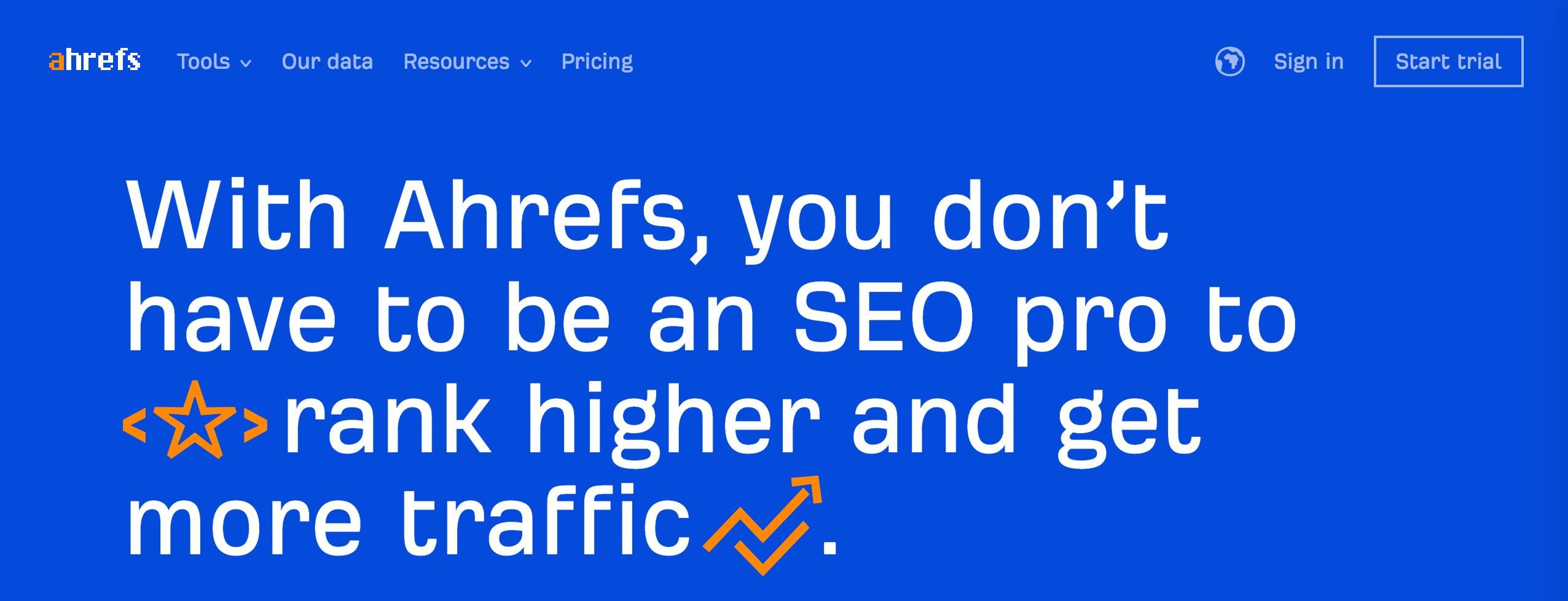Marketing has become a constant battle to figure out how to come up with content ideas.
Even if you’ve mastered the art of repurposing and moved away from the “content for content’s sake” hamster wheel, there’s always demand for fresh new ideas.
But it’s not easy to keep up. Especially when you’re trying to publish the kind of content that attracts a specific target audience and actually converts them into leads and/or customers.
As all-in-one SEO platforms have become more powerful, they’ve become a guiding light for all-things content ideas.
That’s great—but it’s not enough. When you’re thinking of how to come up with content ideas, you need to look beyond the SEO tools.
The Good and Bad of Using SEO Tools to Come Up with Content Ideas

Not every homepage tagline is true to its word. But in the case of Ahrefs, this is pretty accurate.
This all-in-one SEO platform (and others) uncovers so much data that can make the life of any content marketer much easier.
So, it makes sense to trust your idea generation process for your SEO platform of choice. Instead of agonizing over a manual process that’s entirely in your head, you follow the data and come up with enough content ideas to fill out even the most aggressive editorial calendar.
Except that’s not the whole story.
You have to identify the strengths and weaknesses of SEO platforms before going all-in on them for content ideas.
The Good: How to Come Up with Content Ideas with SEO Tools
The overall point of this post is that there’s more to coming up with content ideas than just following data from your SEO tool of choice.
However, that’s not meant to discount the value that those tools deliver.
Whether you’re trying to build out a robust SEO strategy or just need some direction for content ideation, there are far worse places to start than some Ahrefs research.
Here are a few ways to use an SEO tool for idea generation.
Basic Keyword Research
The first (and maybe most obvious) way to generate ideas with an SEO tool is to conduct some basic keyword research.
You already know who your target audience is—what their problems are, what motivates them to make purchase decisions, and what their objections might be to your product.
Some simple brainstorming will give you a seed list of keywords to search for, and an SEO tool will help you fill out a spreadsheet with related phrases to build content around.
Keyword difficulty, CPC rates, and search volume will all impact the actual ideas you come up with. But when you’re able to generate thousands of relevant keywords and topics with some brainstorming and a few clicks, it’s hard to ignore the idea-generation power of SEO tools.
Backlink Research
You don’t have to be a dedicated SEO pro to care about backlinks.
Aside from the technical SEO benefits, backlinks give you a basic indication of how valuable people find a piece of content.
SEO platforms help you research high-level topics that are relevant to your target audience.
Instead of guessing which topics and formats will generate the most engagement, Content Explorer and similar products show you exactly what your audience cares about most. Start pulling that information into your own spreadsheet of backlink analysis, and suddenly you’ll have a whole roadmap for content development.
Competitor Analysis
Another great way to come up with content ideas using SEO tools is to spy on your competitors.
People publish millions of blog posts every day. The odds that your ideas are completely original, never-before-seen, are low. More likely, you’ll be adding your unique perspective to something your target audience already cares about.
This makes SEO competitive analysis a perfect source of content ideas.
Your SEO platform lets you analyze the top pages for any of your search or business competitors. You already know those websites target your ideal customer. Make a list of the pages that bring in the most backlinks and social shares. Then, take the 10x content framework and make the idea your own.
The Bad: When Content Ideas Should Go Beyond SEO Tools
Because organic search traffic remains the holy grail of content distribution, it’s easy to treat SEO tools as the be-all, end-all of idea generation.
But the reality is that organic search is just one of many distribution channels. You don’t have to optimize every single blog post around a specific keyword.
This is most important when trying to do some sort of thought leadership.
When you trust SEO platforms entirely for idea generation, it’s easy to fall into the trap of reactive content creation. You make iterative changes to content that already exists for an audience that’s already searching for a specific phrase.
A first-principles approach to thought leadership means flipping the process. You write about a topic because it cuts to the heart of a problem that’s relevant to your target audience—regardless of the keyword research. A solid piece of thought leadership will likely gain organic traffic over time, but it’s not the primary objective.
Coming up with content ideas beyond what the data says in your SEO tool is vital to the overall strength of your editorial calendar. It eliminates the pitfall so many marketers suffer from—writing for machines instead of humans.
But stepping away from the comforting data of an SEO tool makes idea generation much more daunting.
You can’t just brainstorm a few ideas, throw a blog post together out of thin air, and hope for the best. There’s a real art to figuring out how to come up with content ideas without that SEO platform safety net.
How to Come Up with Content Ideas: 3 Methods to Leverage
If we take away the crutch of all-in-one SEO platforms, what are we left with for generating content ideas?
Plenty more data-driven methods than you might have thought.
When you’re trying to figure out how to come up with content ideas that will really resonate with your target audience, give these 3 methods a try.
1. Talk to Your Customers
This should be the most basic foundation of any content strategy.
Your customers have the most accurate insight into what matters to your target audience. They’ll give you insight into their path to your website. They’ll tell you exactly which pain points they experienced before choosing your products. And they’ll help you gain an unbiased perspective of your products compared to the competition.
All of this is invaluable fuel for content idea generation.
If you can’t get your customers on the phone, analyze your CRM and make the most detailed buyer persona possible. And if you want to go a step further, you can look into the social media activity of people who match that persona.
2. Collaborate with Sales
The next best thing to talking directly to your customers? Having in-depth conversations with your colleagues on the sales team.
They’re on the front lines day in and day out. If anyone is going to know what your customers care about, it’s them.
And better yet, they might be able to give you specific content ideas that will generate real revenue for your business. They might need you to create a specific case study about a common use case. Or, they might be able to guide your next eBook offering by explaining which topics come up most on customer calls.
At the very least, dig into some call recordings from sales calls and start identifying the content-related patterns.
3. Take Advantage of Twitter Search
You want to create content that generates engagement. Why not do your research from the source? Spend some time searching relevant topics on Twitter and see what content gets the most attention.
There’s an important distinction to make between going directly to Twitter search and using social sharing reports.
Tools like Ahrefs and BuzzSumo will give you enormous insight into the content that generates social shares. That’s great data to work with. However, it might lead you to mimic evergreen content that was published years ago by some of the highest-authority sites online.
Directly searching on Twitter gives you a real-time view. You can see the content that generated buzz quickly and the kinds of people who shared it immediately.
More importantly, you get the context of the actual tweet itself. How are people distributing content to gain attention? What angle can you take to generate the most engagement possible? Which headlines work best for your target audience?
All of this can be easier to understand by looking through tweets firsthand.
You Don’t Have to Come Up with Content Ideas Alone
Idea generation can often feel like a solitary job. You run reports on your own. You conduct research on your own. And you jot down ideas as they come to you.
Maybe you have a brainstorming session here and there, but they can quickly turn into wasted meetings.
If you’re struggling to figure out how to come up with content ideas, you don’t have to power through on your own.
Let freelance writers fill in the gaps. Having a writing team at your disposal can give you dozens more content ideas than you could have come up with on your own
Take advantage of the help, fill out your content calendar, and start publishing the kind of work that attracts your target buyers.
